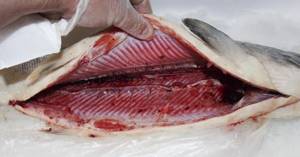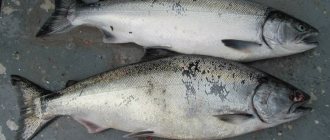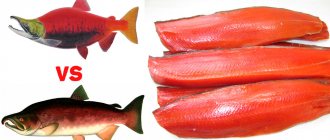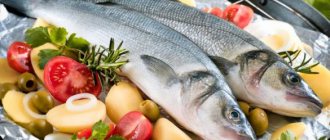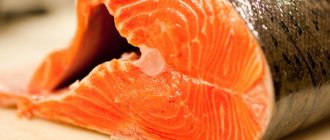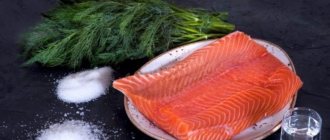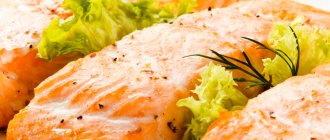What kind of fish is salmon, and what are its varieties?
The salmon family includes a number of biological fish species. All vertebrates were conditionally divided into two groups: Pacific and true. The list of representatives of the first group includes such specimens as pink salmon, chum salmon, sockeye salmon and chinook salmon. The second division includes all types of trout and salmon.
There are many varieties of salmon, but salmon is considered the most striking and “classic” vertebrate. Large numbers of the predator can be found in the waters of the Pacific Ocean, in the rivers of the Northern Hemisphere and the Atlantic. The body length of individuals can start from a few centimeters and reach two meters. The lifespan of fish is several years, some individuals can live 50 years.
To make salmon fishing as productive and interesting as possible, you should choose high-quality gear.
In the waters of the Pacific Ocean you can find a large number of salmon
You can catch a predator in the following ways:
- for spinning - a universal and easy-to-use tackle. It is recommended to select a rigid structure, with a length of 1.8 to 2.4 m. The test rod should be in the range of 10-40 g. In particularly difficult conditions, the length and weight of the structure can be increased (you should focus on the area where fishing will be carried out, casting distance, vegetation and other factors). The recommended thickness of the spinning line is 0.3-0.4 mm;
- fly fishing - the recommended rod length for this gear is 2.7-5 m. This fishing method is considered the most active because it requires frequent casts. To get maximum pleasure, you should use lightweight designs. The choice of gear largely depends on the fishing conditions. Casting can be “wet” or “dry”. The difference lies in the bait the fisherman uses.
It is very important to choose an effective bait and fish during a favorable period of the year (fish spawn in the fall, so fishing is prohibited). No less valuable will be information about the difference between salmon and salmon. Thanks to this, the fisherman will accurately determine the type of catch.
Similarities between salmon and chum salmon
- Pedigree . Both fish are from the salmon family. The meat and caviar of which are highly valued and considered a delicacy in all countries of the world.
- Habitat and spawning . The habitat and life cycles are similar. For most of their lives, salmon and chum salmon live in the cold, salty waters of oceans and seas. To spawn, fish go on a long journey, which ends in fresh rivers with steep rapids. Before spawning, their food consists of small fish and crustaceans. During spawning, individuals stop feeding and lose weight. They lay from 7 to 25 thousand eggs, which are highly valued for their large elastic eggs of bright orange color.
- Benefit . Chum and salmon meat is very nutritious and rich in vitamins, fatty acids, micro- and macroelements. Regular consumption of these fish, as well as their caviar, can strengthen the immune system and normalize the cardiovascular, nervous and digestive systems.
- Harm . People who are allergic to fish or seafood are strictly prohibited from eating salmon or chum salmon. There are cases when allergies manifest themselves to additives, antibiotics or feed components; this only applies to artificially raised animals.
Let's look at the differences between salmon and chum salmon.
What kind of fish is salmon?
Salmon is considered one of the most “noble” fish. It is widespread, especially in Russia, and is considered a delicacy.
Salmon is considered one of the most “noble” fish
Having caught a fish from the salmon family, you need to have certain knowledge to know what salmon looks like. So, the “noble” predator has a long body, compressed at the sides. The color of the individual is silver, the scales are small. The presence of a small adipose fin located opposite the anal and behind the dorsal fin indicates that it belongs to salmonids. A special feature of this type of fish are x-shaped spots that are located above the lateral line. The maximum weight of the predator reaches 43 kg, length – 1.5 m.
The color of the scales can also determine the age of the fish. For example, young individuals are distinguished by their dark color and transverse spots, spawning females acquire a bronze tint, and adult specimens have a white abdomen and a green or bluish back.
Appearance
Chum salmon and chum salmon belong to the salmon family. If we look at these types of fish in more detail, we can notice a large number of differences.
| Characteristics | Chum salmon | Salmon |
| body length | 90–100 cm | 100–150 cm |
| weight | up to 15 kg | up to 45 kg |
| external features |
|
|
| meat |
| from pale pink to red-orange depending on what the fish eats |
| life expectancy | 6-7 years, maximum 10 | 13–15 years old |
We suggest you familiarize yourself with Reducing blood sugar using folk remedies quickly in one day: bay leaf, cinnamon and kefir, turmeric, buckwheat, beans, activated charcoal.
As can be seen from the description, these two types of fish will be quite different from each other. Especially at a young age.
Important! Chum salmon spawn only once during their entire life cycle, and then die. Salmon can lay eggs 1 or 2 times in their entire life, but do not die after that.
Chum salmon has an almond-shaped body that is colored silver. When entering the river, the color changes to dark purple with dark crimson or purple stripes. Chum salmon's tongue, palate and body turn black closer to spawning. At the same time, the teeth enlarge, and its meat becomes whitish and flabby, as in the photo. Juveniles living in the river have black stripes on their sides.
There are two forms of chum salmon: the first reaches a maximum length of 80 centimeters, and the other 1 meter and weighs up to 16 kilograms. Chum salmon looks almost like the pink salmon shown in the photo below, but it has larger scales and fewer gill rakers. Chum salmon do not have the black spots that pink salmon have. In addition, her sexual characteristics appear weaker before spawning, while male pink salmon grow a large hump. This fish lives up to 7 years.
The main advantage of both species is the high content of polyunsaturated Omega 3 and Omega 6 acids, the content of which salmon exceeds other “waterfowl”. Pink salmon is the most affordable in terms of price, but you rarely see a large-sized specimen, since after spawning, as a rule, the fish dies.
Throughout her short life, she eats food high in calories, so her meat is hard, and even somewhat “dry,” as some housewives believe. If you look from the point of view of taste and look for the answer to the question of what is better than pink salmon or chum salmon, then, most likely, many will prefer the second.
It was not in vain that we began to compare these salmon varieties, because it is chum salmon that ranks second among salmon in terms of numbers and popularity. This fish is larger, and although its meat is even drier, it is not so fatty, but if you want to know what is tastier than chum salmon or pink salmon, you should rely on your own taste.
What is the difference between salmon and salmon?
Every fisherman should know how salmon differs from salmon. This information will help you decide on the type of catch and navigate the fishing industry. Perhaps the main difference between fish is that salmon is a general name for a family of vertebrates, which can imply several species of predators at once, while salmon is a specific species that has characteristic features unique to it.
Let's figure out how to distinguish salmon from salmon? The fishing location will help you decide on the type of vertebrates. Salmon live in Pacific and Atlantic waters and can also be found in European rivers, while salmon primarily live in lakes, northern Europe and the Atlantic.
The differences between predators are in taste and size
Differences between predators also lie in taste and size. Salmon is considered less fatty and has a more pronounced taste. To know how to distinguish salmon from salmon, you need to study the color features of the fish. With the help of these skills, not only fishermen will be able to recognize their prey, but also buyers will be able to determine what is on store shelves.
Which fish is best for salting?
The difference between the described types of salmon will also be noticeable when the fish is salted. If you want to prepare a product for further use in creating sandwiches, first or second courses, then you should give preference to pink salmon, with a high level of fat content.
The meat of more expensive chum salmon is also often used with this preparation option, but at the same time, less fatty salting will later become an excellent addition to salads or appetizers. The salting method may not be different, but in the end you will still end up with a product with a different aroma and taste.
Despite the difference in size, appearance, meat composition and range of beneficial properties, both chum salmon and pink salmon deserve the attention of consumers. With proper preparation and selection of additional ingredients, both fish will delight you with an appetizing aroma, good taste and attractive appearance of the dishes.
Difference in taste
In stores and supermarkets, seeing almost the same fish, it is difficult to understand how salmon differs from salmon and which predator should be preferred. In fact, it all depends on a person's preferences. The products are almost the same price.
Therefore, in order to answer the question: “Salmon or salmon, which is better?”, it is recommended to try two types of fish. Some types of meat are fattier, others have a distinctive taste, but all products are definitely a storehouse of nutrients.
The difference between salmon and salmon can be noticed after cooking. The second type of fish has a balanced aftertaste and is perfect for cooking steaks. Vertebrate bones are used to make soups. Salmon soup is considered a real delicacy.
To prepare an excellent dish, you need to purchase the following products:
- salmon;
- potato;
- carrot;
- dill;
- spices.
The process of preparing the soup takes no more than half an hour. The salmon is boiled for twenty minutes, after which the remaining ingredients are added. Cook the fish soup over low heat.
There are also many recipes for brining salmon. The preparation method is very simple: fish fillets need to be peeled and dried. At the next stage, the product is placed in a deep container and covered with salt (1 teaspoon per 0.5 kg of meat). To enhance the taste and piquant aroma, add soy sauce, allspice, bay leaf, coriander and other spices. The fish must be under pressure. In just a day you will be able to enjoy the most tender salmon meat.
In order to provide adequate nutrition, it is important for a person to include as many varied foods as possible in their diet. In addition to meat, vegetables and fruits, it must be fish and seafood, rich in essential vitamins and minerals. Among the wide variety of representatives of the ichthyofauna, salmon species deserve special attention, among which there are both common species and real exotic ones. Today we want to talk about what is healthier: salmon or pink salmon, which is part of the salmon family.
Harm and contraindications
Chum salmon meat has virtually no side effects. This fish suits everyone. The exception is people with protein intolerance or allergies to fish and seafood.
Fish has virtually no contraindications, but people prone to allergies should treat it with caution or completely exclude it from their diet. For example, if a reaction to protein or specifically to seafood was noticed. You should not eat chum salmon if there are individual signs of intolerance to the product.
Fried fish in oil is contraindicated for patients with problems with blood vessels, heart, liver or kidneys. It is better to boil or steam the meat. This way it will also be tasty, and most importantly – safe.
What is the difference between pink salmon and other salmon
Now we are faced with a difficult task - to say which is better, although in the first case it is one of the most common types of the second. The task is complex, so we will reduce it to comparing the composition and beneficial properties of the remaining representatives of this family with the “humpback”, which is the most numerous and popular today. The main reason for this popularity is the affordable price, the ideal consistency of the meat and red caviar, the benefits and taste of which are appreciated by many.
Before we say which salmon or pink salmon is tastier, let’s talk about the external differences between the latter and coho salmon, sockeye salmon, chum salmon, chinook salmon, salmon and other members of the family. Unlike the same salmon, which in the wild can reach enormous sizes and weights of 20-40 kilograms, this fish with a hump in the male has the smallest sizes - its weight rarely exceeds 2 kilograms, and the body size of an adult is 60-70 centimeters. Meanwhile, it is this representative of the family that grows the fastest, since it is not a fussy eater and prefers to spend the winter in fairly warm water.
Chum salmon in cooking
Red fish is an excellent “raw material” for creating real culinary masterpieces. This delicacy can be fried, baked, boiled, stewed, pickled and salted. Salmon can serve either as an independent dish or as a component of more complex culinary variations.
Chum salmon meat has delicious gastronomic characteristics. But it is important to cook the fish correctly. Chum salmon is one of those sea creatures whose fillet is absolutely not suitable for frying. This type of heat treatment makes the meat dry and tasteless. Therefore, if you fry fish, do so exclusively using batter. Bake in foil or in a sealed container.
In supermarkets, chum salmon is available frozen, chilled, salted or smoked. Fresh carcass is good for fish soup and other hot dishes. Salted pieces can be used to prepare salads and other cold appetizers (but this type of chum salmon usually needs to be washed to remove excess salt).
- Defrost chum salmon in 2 stages. The first one is in the refrigerator. The second is at room temperature. This way, the beneficial substances and correct consistency of the fillet will be preserved as much as possible.
- The scales will come off easier if, before cutting, the carcass is first poured with boiling water and then dipped in warm water and vinegar.
- It is better to bake chum salmon than to fry it. And if you fry, then only in batter (to maintain juiciness).
- Before cooking, marinate pieces of fish (or carcass) in lemon juice.
Properly salted tender pink fish meat will serve as a tasty and beautiful addition to the holiday table. This method of cooking will also help to significantly extend the shelf life of the product. And most importantly, both fresh and frozen carcasses are suitable for salting.
So, let's start cooking. The first step is to prepare the carcass: defrost, rinse, remove fins, remove the skin. Divide the fish into large pieces and prepare the mixture for pickling. To do this you will need salt and granulated sugar in equal quantities. If desired, the mixture can be “revitalized” with pepper, fish spices, coriander, bay leaf, and nutmeg.
It is also permissible to add a little vegetable oil. But the main thing in this matter is not to overdo it, so that the spices do not dull the natural taste of chum salmon. Mix all ingredients thoroughly and gently roll each piece of fish in the sweet and salty “powder”. Place the fish in a pan (enamel or glass), pressing tightly. Place in the refrigerator for a day. Cooked fish is delicious as a cold appetizer or sandwich product.
The value of this snack will be appreciated by gourmets of any age. Moreover, it cooks very quickly. All you need is lavash, salted chum salmon, processed cheese, and herbs. Place slices of salted chum salmon on lavash spread with melted cheese and sprinkle with chopped onion. Form a roll and put it in the refrigerator (to harden). Serve in slices.
Chum salmon "pearl pearl"
Boil the barley soaked in the evening in salted water. Cut the raw chum salmon fillet into pieces and simmer in vegetable oil with the addition of water (with the lid closed). In a separate pan, simmer the onions, zucchini, carrots and tomatoes. When all the ingredients are ready, place the vegetable mixture on a plate, with a portion of chum salmon on top. As a garnish – pearl barley. To serve effectively, the porridge can be spread in a thin layer on top of the fish.
We suggest you familiarize yourself with How to treat acidic soil
Peel the chum salmon, but do not cut the belly (make a cut across the belly). Rub the carcass with the spice mixture and place in the refrigerator overnight. Prepare a mixture of salt, pepper, coriander, lemon balm, dill, lemon (zest and juice). Use mushrooms with rice as minced meat. Bake in the sleeve for about 40 minutes. Serve with steamed carrots, cauliflower, broccoli.
Red fish has earned its popularity not least due to its delicious taste. But the right delicacy is not only tasty, but also healthy. And chum salmon is a clear confirmation of this.
More fresh and relevant information about health on our Telegram channel. Subscribe: https://t.me/foodandhealthru
Which is healthier and tastier?
If you want to know what is better, salmon or pink salmon has a wider distribution area, unlike other members of the family, which are found in a narrowly limited area. As you know, salmon is valued not only for red meat, but also for caviar. As for caviar, each species has a different color, and the sizes of the eggs also differ. In the case of the pink salmon, it is a pale orange color and the eggs are medium-sized, unlike other salmonids, which have a more pronounced red color.
Speaking about what is healthier, it is worth paying attention to the chemical composition, and all fish of the salmon family contain the main thing - polyunsaturated fatty Omega 3 acids, which help remove excess cholesterol from the body. The vitamin and mineral composition is also striking, and this is a huge amount of essential vitamins, micro- and macroelements that have a beneficial effect on the human body. Speaking about what is tastier than pink salmon or salmon, it is also worth paying attention to the characteristics of the meat, and in the case of “humpback” it is somewhat dry and less fatty. It is ideal for any cooking method, but it is especially good when pickled.
The remaining members of the large family are tasty in their own way, they have different caloric content and nutritional value and are indicated for consumption even as part of a diet. Speaking of contraindications, it is worth saying that red fish meat, like its caviar, can be consumed even by those who have problems with excess weight, children and adults, but in any case it is worth remembering that you should not abuse this valuable product.
Fish is one of the most important products that must be present in every person’s diet; it contains a huge amount of protein, vitamins, macro- and microelements. The most popular are red fish, namely chum salmon, coho salmon, pink salmon, and sockeye salmon. They contain high concentrations of polyunsaturated acids, which protect the human body from many serious pathologies.
Differences between chum salmon and pink salmon
Chum salmon is one of the types of Pacific salmon, but, based on the specific habitat of the fish, it can be divided into subspecies: summer and autumn, and the latter is always much larger (found in the waters of the northern part of the globe).
Pink salmon (or as it is called “pink salmon”) also belongs to the Salmon family, but prefers exclusively cold water, with a temperature no higher than 15 °C. If the thermometer goes beyond 20 °C, the entire school of fish dies.
Important! Pink salmon meat is much richer and fattier than chum salmon, but at the same time, it is the latter that is less common and is more valued.
Among the external differences between these two varieties of salmon are the following:
- Pink salmon is always lighter and smaller than chum salmon, which, with a maximum length of 1.5 m, can weigh up to 15 kg. At the same time, it is the first one that grows faster, reaching 40 cm in length and a weight of 2 kg in just a few years. This phenomenon is partly explained by natural factors: the rapid death of pink salmon shortly after spawning.

- Outwardly, pink salmon has more interesting data, since its sexual dimorphism is much more clearly expressed: during the spawning period, the upper jaw of males bends and a hump appears, and spots form on the body of females. Until this moment, individuals are tricolor: the back is blue or blue-green, the sides are silver, and the belly is almost completely white. At the same time, the body of chum salmon most of the time has an unremarkable, quite standard silver color, and it changes only during the spawning period, sometimes to yellow-brown or bright crimson. When spawning, the color of the females becomes almost black.
Did you know? There is an opinion that regular consumption of pink salmon meat will serve as a good preventive measure for the development of diabetes, since 100 g of the product contains the daily requirement of chromium, which takes part in regulating blood glucose levels.
As for caviar, chum salmon is more highly valued and is considered a real standard among similar products. Although the fractions are quite large, with a diameter of 6 mm in both types of fish. Chum salmon have a dense shell that does not burst even under mechanical stress (stirring with a spoon), and the eggs hold their shape for a long time. This product is preferred during the holidays. Salmon caviar is less resistant to damage, but is also highly valued.
Chum salmon and salmon belong to the same family of fish. Varieties have both similarities and differences. A greater difference is seen in external data and life cycle than in taste characteristics.
Comparative characteristics
Quite often you can hear pink salmon referred to as salmon, believing that these definitions are completely interchangeable. Meanwhile, this is not exactly the same concept. Salmon is a separate genus of fish; it includes chum salmon, as well as sockeye and chinook salmon, and pink salmon, the latter being considered the smallest of all species. The length of the carcass almost never exceeds 60-75 cm, and the weight of the fish is approximately 1.5-2.5 kg.
The fish got its name thanks to the hump that “decorates” the back of the male during the mating season. A characteristic feature of pink salmon is its large, light, almost white mouth, as well as the absence of teeth on the tongue. This fish has small oval dark spots on the carcass and a V-shaped tail.
Compared to other fish of the salmon family, pink salmon grows and gains weight much faster than others. This is largely due to the fact that she eats quite high-calorie food - fry, as well as crustaceans and various small fish. In addition, accelerated growth is greatly influenced by the fact that pink salmon winter in waters where the average temperature does not fall below 5 degrees Celsius.
Unlike other salmon, pink salmon caviar is lighter in color and the shell is quite strong. In addition to caviar, fish pulp is widely used in cooking. It is quite dry, but nevertheless quite suitable for preparing a variety of dishes, as well as canning and pickling. Pink salmon is exceptionally healthy: it contains quite a lot of Omega fatty acids, as well as vitamin PP.
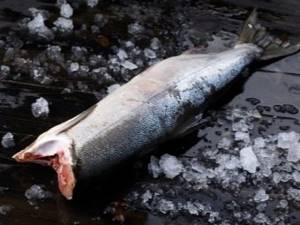
Pink salmon
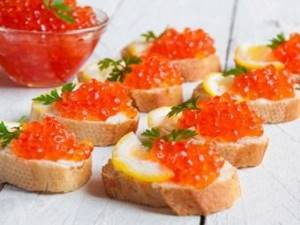
Pink salmon caviar
Summarizing all of the above, we can draw the following conclusions.
- Pink salmon is one of the most common representatives of the vast genus of salmon; in science it is called “Pacific salmon”. It is not entirely correct to say that pink salmon is salmon, since salmon is a collective term that includes many different fish.
- Pink salmon differs from other salmon species in its relatively small size, certain external features, and wider habitat.
It is worthwhile to dwell separately on the differences between pink salmon and chum salmon; these are the subspecies of red fish that are most popular on our shelves, they account for 80-85% of the total catch of fish of this species. Chum salmon in nature occurs in summer and autumn. The summer fish lives in the northern regions, and the second - in the southern regions, while the autumn fish is much longer than the summer fish. This representative of salmon is characterized by a keen sense of its homeland: it spawns in the place where it was born.
Pink salmon prefers to live in fairly cool waters: its usual temperature is 15 degrees; in hotter climates it simply dies. In terms of calorie content and concentration of polyunsaturated acids, pink salmon is significantly superior to chum salmon. Unlike the latter, for spawning it always selects more and more new places, as a rule, these are rivers with large pebbles at the bottom. After birth, the fry hide in stone burrows for some time, and then swim out into the water column, from where they are carried into the ocean by a fast current.
Let's look at other differences between these types.
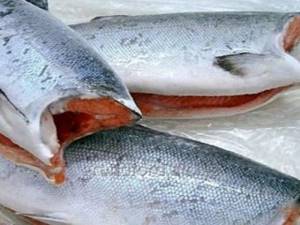
Chum salmon
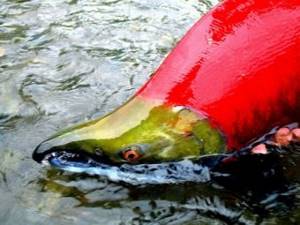
Red salmon
Length and weight
Chum salmon grow to approximately 1.5 m, while pink salmon are half the size. Moreover, the first one weighs 10-15 kg, and the second one is almost 10 times lighter. At the same time, pink salmon grows faster than chum salmon.
Appearance
Chum salmon has a rather unremarkable color with a distinct silvery tint, and at the time of spawning, pinkish spots appear on the body of the fish. Pink salmon has dark oval spots on the carcass; in addition, this fish has quite pronounced characteristics of the genus. Thus, males have a curved upper jaw, rather large teeth, and a hump grows on their back during the breeding season.
However, inexperienced consumers quite often confuse these two fish, which is sometimes taken advantage of by irresponsible sellers.
Habitat
Chum salmon lives and reproduces exclusively in its natural environment, which is why its pulp is very highly valued, since this fish grows without the use of all kinds of antibacterial drugs, hormones and various growth stimulants. At the same time, chum salmon can live in both salty and fresh water bodies; among all representatives of the salmon genus, it is characterized by the most extensive habitat zone.
Pink salmon prefers the seas and rivers of the northern hemisphere; in most cases, it is localized off the coast of the Pacific Ocean, as well as in the Arctic, while the fish constantly migrates from the seas to large rivers, and then back. Pink salmon living in the ocean are distinguished by a slightly bluish or light green back, pronounced silver spots on the sides and a snow-white belly, and when this fish returns to its native fresh water bodies, the belly becomes yellowish.
The nutritional value
Consumers have been debating for quite some time about which fish is better and tastier - chum salmon or pink salmon, and cannot come to a consensus. This is not surprising, because both fish are extremely nutritious and healthy. Both types are classified as fatty varieties; they contain very high concentrations of fatty acids and microelements necessary for health. However, pink salmon has a slightly more high-calorie pulp: 100 g of product contains about 145-150 kcal, the fillet is fattier, its consistency is quite dense, and the color is pale pink.
Chum salmon fillet is drier and not so fatty; this product is classified as dietary, its calorie content is only 125 kilocalories. At the same time, the fish contains more B vitamins than pink salmon, and the composition of minerals is much more balanced: quite high concentrations of iodine, fluorine, as well as cobalt, manganese and chromium have accumulated here.
Caviar
As for caviar, between chum salmon and pink salmon it differs quite significantly both in its appearance and chemical composition. Chum salmon caviar is slightly larger, the color is rich scarlet-orange. Pink salmon eggs are slightly smaller in diameter, but they are covered with a rather strong outer shell. The taste qualities of both fish are exceptionally high, but chum salmon contains much more protein, and in a form easily digestible by humans. Chum salmon caviar is considered more nutritious and healthy.
general characteristics
Chum salmon is a type of Pacific salmon.
This red fish is second in popularity only to the more affordable pink salmon, although chum salmon is the most common among other salmon. The weight of an adult carcass can reach 14-15 kg, and its length sometimes exceeds a meter. This fish belongs to the marine predators. The main delicacy for her is crustaceans, from which, in fact, she gets the red pigment for her meat.
This fish lives in the northern part of the Pacific Ocean, in the waters of the Bering and Okhotsk seas, as well as off the coast of North America. At 3-4 years of life, chum salmon are ready to spawn. And for this she goes to the rivers of Japan, the USA, Korea, the Kola Peninsula and the northern part of Primorye. It is interesting that she goes to spawn precisely to the waters of the river where she was born several years ago. No less curious is how chum salmon recognizes its native waters - it tastes it.
During such a journey, chum salmon meat loses its benefits. Pale brown, dull, devoid of healthy fats - this is what chum salmon fillet looks like during the spawning period. Not least due to the fact that, having entered the river waters, she stops eating and lives solely off of “reserves”. The appearance of the fish also changes: instead of the usual silver color, it becomes dark, almost black, and the teeth increase several times.
Salmon (Salmo salar) belongs to the salmon genus
. It is also called Atlantic salmon. The maximum length of an individual is one and a half meters, weight is about 40 kilograms. Lives for approximately 13 years.
A distinctive feature of salmon is its bright silver scales and darker, blue-tinged back, without spots.
The color of salmon meat varies from pale pink to red-orange, depending on the components of the fish feed. Every year the number of salmon in the wild decreases. Since September 2021, it is listed in the Red Book of Russia. Modern fish farms are engaged in its artificial breeding. In Norway, for example, there are a lot of fish farms where salmon are raised. But the taste and quality of such fish is much inferior to wild representatives of this genus.
Chum salmon - a species of Pacific salmon
. The catch of which breaks world records.
The maximum length does not exceed 100 centimeters, weight - 15 kilograms.
Appearance varies depending on hydrological conditions. In ocean water it has a uniform silver color. In fresh water, its color darkens and its jaw becomes larger. Chum salmon meat is bright pink.
How to tell the difference?
In conclusion, we will give a brief overview of the distinctive features of pink salmon from some other salmon in order to understand what the difference between these species is. Inexperienced buyers quite often purchase pink salmon instead of sockeye salmon. The flesh of the latter is fattier and contains more vitamins, so it is valued much higher, which is what unscrupulous sellers take advantage of, passing off pink salmon as its more expensive relative. The main difference between these two salmon is their size: pink salmon is at least two times smaller than sockeye salmon. However, there are exceptions, but very rarely.
The tail can tell a lot of interesting things about a fish: if there are fuzzy dark spots on its fin, then this is a pink salmon.
In addition, it has more delicate scales: if these two fish lie in front of you, then distinguishing one from the other will not be difficult. If there is only one fish in front of you, then you can try to count the number of scales in the very first row, located above the lateral line. Typically, in sockeye salmon their number does not exceed 145, while in pink salmon it varies from 170 to 210.
You can make your work easier: just select about a fifth of the length and multiply the number of scales in it by five, this accuracy is more than enough to determine what kind of fish is in front of you.
It is not at all difficult to distinguish pink salmon from fish such as coho salmon, although they are approximately the same in size. Coho salmon have a rather unique color: the head and back have a greenish tint, and the sides and belly are silvery-white. There are transverse stripes on the body, which, unlike pink salmon, are noticeable and located below the lateral line, and oval or triangular spots are visible between the stripes.
During spawning, the scales acquire a pronounced pink tint. Coho salmon meat is very tender and juicy, and this is another difference between the two salmon.
To learn how to distinguish a female from a male salmon, watch the following video.
Fish is the most important product in the human diet. Its benefits have been proven for a long time. It contains vitamins, proteins, and minerals. The meat of red fish (chum salmon, pink salmon) is especially useful. It contains Omega-3 polyunsaturated acids, which slow down the aging process and protect the body from many diseases.
Which is tastier?
The meat of both types of fish has high taste properties: it is fatty and contains a large amount of vitamins, minerals and amino acids. At the same time, pink salmon is slightly fatter, which is due to its habitat in cold waters and the high calorie content of the food consumed. As a result, 100 g of dense pale pink pink salmon meat contains 145–147 kcal.
Chum salmon fillet is dry, orange-pink. Its 100 g contains only 125 kcal, which explains the relevance of its use in the diet menu. Compared to the previous version, it contains much more B vitamins, and this variety tastes more tender and juicy.
Certain differences between these fish lie in the characteristics of their caviar: chum salmon is much brighter, larger and contains a larger amount of protein, which is well absorbed by the human body.

In addition, it contains a considerable amount of vitamins and minerals. Of course, everyone’s tastes are different, but many consumers prefer tender chum salmon meat, although fatty pink salmon products also do not lose popularity.
Important! The taste of both fish largely depends on the method of their preparation, but be that as it may, the natural aroma and taste can be preserved only with a minimal use of spices, especially herbs.
Representatives of the salmon family
Chum salmon and pink salmon are the most common fish of the salmon genus. They make up more than eighty percent of the catch of fish of this species:
- Chum salmon is a type of Pacific salmon. There are two types of fish of this breed: summer and autumn. The first lives in the northern part of the world, the second in the south. Autumn chum salmon are much larger than summer ones. This fish has a highly developed sense of homeland - it always returns to spawn in the same place where it was born.
- Pink salmon is also called pink salmon. She prefers cold waters with a temperature no higher than 15 degrees - at 26 degrees the fish dies. Pink salmon eat high-calorie foods, and their meat is rich and fatty. It is superior to keta meat in terms of caloric content and amount of fat. Pink salmon spawn one and a half years after birth and usually die after spawning. For breeding, she chooses new places - usually rivers with large pebbles. The fry hide in a burrow for some time after birth, then are carried out to the open sea by the current.
Pink salmon and chum salmon differ both in appearance and habitat
.
The difference between the fillets of these fish is small. It can often be found on store shelves. Externally, the fish are also similar, but they have many differences:
Unscrupulous sellers often deceive people who do not know how chum salmon differs from pink salmon.
Chum salmon lives, inhabits and reproduces only in natural conditions. Its meat is especially valuable, as it is grown without growth stimulants and antibiotics. Fish are found both in fresh waters and in seas and oceans. Among salmonids it is especially widespread.
Chum salmon does not have a specific habitat
. Large schools of fish enter rivers to spawn, and young fish leave the rivers for the oceans. During travel to the spawning grounds, its color changes: the fish becomes darker, stripes appear on its body. Its massive and long tail is designed to dig holes for eggs. Sometimes the depth of the pits reaches two meters. In Russia, chum salmon catches are small, which leads to a fairly high price for its meat.
Pink salmon are found in fresh and marine waters of the northern hemisphere. Most often it can be found off the Pacific coast and in the Arctic. Fish constantly migrate from ocean waters to rivers and back, covering vast distances.
Pink salmon begin and end their lives in rivers. Fish spawning occurs in July-September. The fry remain in the rivers until summer, then they are sent on a journey to the ocean, where they live until they reach marriageable age. The fish then return back to the rivers. There they give birth to offspring and die during spawning
.
Pink salmon that live in the ocean have a bluish or blue-green back, silvery sides and a white belly. When returning to fresh waters, the fish becomes pale gray behind, its abdomen acquires a yellowish or green tint.
Buyers often argue about which is tastier - chum salmon or pink salmon. Meanwhile, the meat of both fish is tasty and healthy. It belongs to the fatty varieties and contains a large amount of microelements, vitamins and fatty acids.
Pink salmon has a fattier and higher-calorie fillet. This is due to the fact that it lives in cold waters and eats high-calorie foods. Its meat has a dense consistency and pale pink color. Its calorie content is 145−147 kcal
.
Chum salmon meat is drier and less fatty. It is considered a valuable dietary product as it contains fewer calories. The energy value of tender fillet is 125 kcal. It looks bright pink. Meat contains more vitamins, especially group B, including B5, B6, B9, B12. Pink salmon meat has the best mineral composition: it contains a lot of iodine, manganese, chromium, cobalt, and fluorine.
Chum salmon and pink salmon caviar differ in appearance and composition. In chum salmon it is larger and has a bright red-orange color. Pink salmon caviar is smaller in diameter. It is covered with a dense outer shell. The caviar of both fish has excellent taste, but chum salmon contains more protein, which is completely absorbed by the human body. It also contains more minerals and vitamins. Although there is no dispute about tastes, chum salmon caviar and meat are considered more tasty and healthier than pink salmon.
Sometimes they ask which is better - salmon or chum salmon
. But any fish from the salmon family is called salmon. Therefore, it is incorrect to talk about the difference between salmon and chum salmon, since chum salmon is the same salmon.
We can talk a lot about the benefits of fish dishes. Pink salmon can be considered one of the most valuable commercial fish in this regard: it is quite affordable and is sold almost everywhere, and is very useful due to its high content of vitamins, microelements, unsaturated fatty acids and proteins. Pink salmon is often called salmon. Are these names interchangeable? Or are pink salmon and salmon different types of fish and should not be identified? In the article you will find all the answers to the questions that have arisen on this topic.
How to choose the right chum salmon
Red fish is a very healthy, but also quite expensive product. It enters world markets mainly from the Far East. In Russia, 20 to 30 thousand tons of red fish are caught annually. But only young carcasses are suitable as tasty and healthy food. Meanwhile, inexperienced buyers can sometimes fall for the bait of unscrupulous sellers who, under the guise of chum salmon, offer cheaper types of fillets (for example, pink salmon). To avoid becoming a victim of scammers, just remember a few valuable tips:
- Compared to pink salmon, chum salmon is much larger (the average weight of pink salmon is 2-3 kg).
- The meat of young chum salmon is bright pink.
- A fresh smell indicates that the fish was caught recently.
- The eyes should be shiny, without clouding.
- There should be no bruises or stains on a selected carcass.
- The surface of a fresh carcass should not be slippery.
- After pressing the carcass with your finger, the meat should recover. If this does not happen, the product is stale.
- When refrigerated, chum salmon can be stored for no longer than 8 hours.
For inexperienced buyers, there are some tips for choosing the “right” chum salmon carcass. It is not so easy to distinguish it from cheaper varieties of fish, such as pink salmon, so it is worth listening to the advice of professionals so as not to be deceived by unscrupulous sellers.
- Chum salmon is much larger in size and weight than pink salmon. If the average weight of the latter is only 3 kg, then for chum salmon it will be 5–6 kg or more.
- The meat of fresh young chum salmon is always bright pink.
- If possible, you need to smell the meat. The fresh aroma of the fish will indicate that the chum salmon was caught recently.
- It is worth paying attention to the eyes. They should not be cloudy.
- It is undesirable to choose a carcass with bruises, spots or abrasions.
- You need to try to check the elasticity of the meat. If, when you press on the carcass, the dent quickly disappears and the body of the fish returns to its original form, then you can take it. If the dent remains, it means that the chum salmon is not the freshest.
- Fresh chum salmon has a slippery body surface.
Storage
Depending on the condition of the fish, different storage options are used.

Fresh
Fresh chum salmon can be stored in the refrigerator for no more than two days, then you urgently need to cook something from it, otherwise the fish will disappear. Before sending it for storage, it is necessary to carry out preparatory work, which includes cleaning the scales and removing the entrails. Then rinse the fish thoroughly, dry with paper towels, place in a separate bowl and cover with a lid. You can use cling film or a clean plastic bag. Salt or fresh lemon juice can be used as a preservative for storage.
Salty
We suggest you find out what percentage of alcohol is in red wine
Salted chum salmon can be stored fresh at home much longer. For example, the shelf life of lightly salted fish is 3 days, and vacuum-packed salted fish is 1 month. Heavily salted fish can be stored for 30 days.
To extend the shelf life of chum salmon, you can use vegetable oil, in which you place pieces of fish or the whole carcass. Then the period will increase to 3 months.
You can salt fish yourself, using all the rules and precautions when salting food. Properly salted chum salmon, prepared with your own hands, can be stored in the refrigerator for up to 25 days.
Smoked
Red fish species are usually smoked either hot or cold. The shelf life of hot-smoked fish is no more than 3 days, while cold-smoked chum salmon lasts up to 10 days. It is advisable to store such products in paper bags in the refrigerator.
Dried
The dried option is the most reliable. Its shelf life is practically unlimited. Throughout the year, you can delight your household with a dried delicacy. But for proper storage, you need to wrap the fish in thick paper and place it in the refrigerator on the middle shelf.
Cooked chum salmon
Boiled, stewed or other fish can be stored for no more than 2 days. And for rolls and sushi using red fish, the period is even shorter - 1 day.
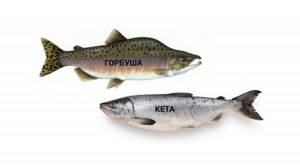
Freezing
To freeze the fish, you need to prepare it: remove the entrails and distribute it into bags. You can use foil. In this form it can be stored in the freezer for several months. It is worth defrosting only before eating, and in a natural way. No hot water or microwave, otherwise the fish will lose some of its beneficial qualities and taste. Everything must be done gradually:
- Transfer from freezer to refrigerator.
- Keep it there for several hours, depending on her condition.
- As soon as the fish begins to show any signs of thawing, remove it from the refrigerator and let it defrost indoors. The temperature should be room temperature.
- Repeated freezing is not recommended, so you need to initially pack the fish into small pieces before freezing. Then take out exactly the amount of chum salmon that is needed to prepare a specific dish.
To choose high-quality coho or chum salmon, you need to adhere to some rules.
- Shiny scales that fit tightly to the meat without spots or bruises are the main signs of a good fish. It is better not to take salmon with irregularities and bruises.
- When purchasing fresh fish, press on the surface. In fresh fish, the pit will quickly disappear. If this does not happen, it means that the storage conditions were violated.
- When buying a whole fish, you need to look at its eyes. For a quality product they should not be cloudy.
- The surface of the carcass should not be sticky. Ideally it is smooth and slightly damp.
By following all these rules, you can choose high-quality fish for preparing delicious dishes.
Relatively recently, salmon fish were considered elite, but today they are quite affordable for every Russian, and other countries love this tasty meat with a reddish tint. Meanwhile, a person is often faced with a choice, and has to decide which is healthier than pink salmon or chum salmon; other varieties are also compared, but this fish is considered one of the most common.
Difference between pink salmon and salmon
The Pacific salmon genus includes several distinct species, including pink salmon, chum salmon, coho salmon, sockeye salmon, masu salmon and chinook salmon. Pink salmon is the most numerous and smallest of them fish. It rarely grows to 65-70 cm, the average carcass weight is about 1.5-2 kg. Pink salmon owes its name to the hump that appears on the once flat back of the male fish during the mating season. The distinctive features of pink salmon are a white mouth with no teeth on the tongue, large dark oval-shaped spots on the back, and a V-shaped tail. Pink salmon, compared to other salmon, grows and gains weight very quickly. This is due to the high-calorie foods (crustaceans, fry, small fish) that she prefers. Also, the rapid growth rate of this fish is influenced by its habit of staying for the winter in areas where the temperature does not drop below five degrees plus. Pink salmon have large, pale (compared to other members of the family) caviar with a fairly dense shell. In cooking, both the meat of this Pacific salmon and caviar are used. The meat is a little dry, but is suitable for a wide variety of dishes, including salting and canning. Pink salmon is very useful. Of particular value are the nicotinic acid, vitamin PP and unsaturated fatty acids it contains.
What is the difference between sockeye and salmon
Both sockeye and salmon are characterized by a pleasant taste and high content of nutrients. However, they still differ.
Let's compare these two types of red fish:
| Red salmon | Salmon |
| Mined mainly abroad, in the USA | Mined and bred directly in Russia |
| Has a delicate taste | Has a bright, rich taste |
| Has a fine, melting texture | Has a dense texture similar to regular salmon |
| Contains up to 15% fat in meat | Contains up to 5% fat in meat |
| Good when salted | Good when salted, boiled, fried and smoked |
| Does not tolerate heat treatment well | Suitable for boiling and frying |
| Suitable for feeding children | Not suitable for feeding children |
| Used for caviar fishing, although the finished product is not for everyone | Caviar is rare and poorly stored |
Thus, sockeye salmon is best chosen by those who want to enjoy the subtle range of taste of red fish and its delicate texture. It is also perfect for inclusion in the winter diet, as it is rich in fat, containing vitamins and microelements.
Salmon, in turn, is a fish for those who love a rich, rich taste. In addition, it is perfect for cooking dishes that require heat treatment, including steaks and steamed fillets.
It cannot be said that one breed is much better than another in all respects. It is recommended to choose based on your own preferences and try both.
Coho salmon: characteristics, composition, benefits
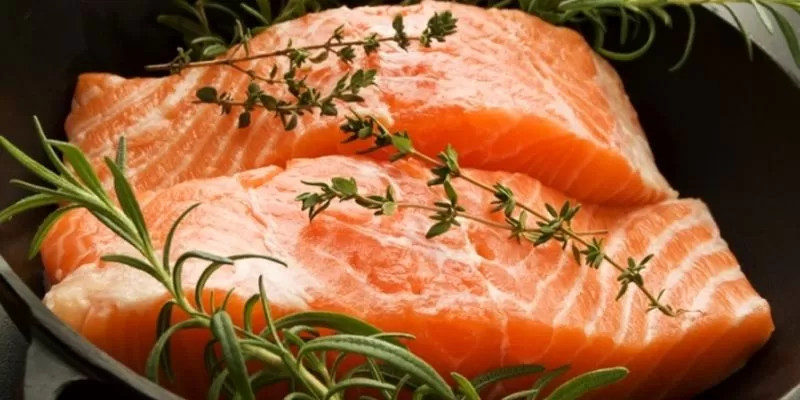
The largest fish in the salmon family. “Silver salmon” (as it is called in the vastness of the USA and Japan) can be safely called a real giant: it reaches a meter in length and weighs more than 15 kg. Habitat: Mainly the Kamchatka coast up to the rivers of the Sea of Okhotsk and the eastern shore of the island. Hokkaido. In the natural environment, coho salmon are found in small numbers - hence the high price.
In our country, coho salmon is known under another name – “white fish” and is considered a delicacy. Coho salmon meat has a rich coral color, and the taste is perfectly balanced. Although silver salmon can hardly be called a dietary product, a dish prepared from it will be useful for children, the elderly, and those who are watching their calorie intake.
Coho salmon meat contains a lot of valuable substances:
- Vitamins A, C, E, group B;
- Molybdenum
- Chromium;
- Fluorine;
- Sulfur;
- Iron;
- Nickel;
- Magnesium;
- Calcium;
- Phosphorus;
- Astaxanthin (carotenoid), etc.
IMPORTANT! Coho salmon,
Undoubtedly, it is replete with useful components, but it also has a certain peculiarity - 100 meat of this fish contains almost 63 g of cholesterol. Therefore, the product should be used with extreme caution.
White fish can be consumed not only to pamper the taste buds and stomach, but also to have a healing effect on the body. Coho salmon are known to:
- Reduces the risk of stroke and the development of atherosclerosis;
- Strengthens the nervous system;
- Increases hemoglobin;
- Minimizes the possibility of developing osteoporosis;
- Strengthens vascular walls;
- Speeds up metabolism;
- Purifies the blood;
- Strengthens bone tissue;
- Prevents the influence of radionuclides, etc.
The product should be used with caution by those who suffer from chronic diseases of the gastrointestinal tract, liver, kidneys, or allergies to seafood.
Chum salmon
Chum salmon ranks second in abundance among Pacific salmon.
Chum salmon, unlike pink salmon, is devoid of spots in color. It is rich in vitamin B1, as well as phosphoric acid. Periodic consumption of chum salmon helps reduce cholesterol levels, improves blood supply to blood vessels, stimulates metabolism, has a positive effect on brain activity and vision, slows down inflammatory processes and improves immunity. Chum salmon is a very tasty and aromatic fish, but you should not cook it in traditional ways, otherwise it may turn out to be dry. It is ideal to bake chum salmon in foil or with vegetables. Also popular representatives of the Pacific salmon genus are sockeye salmon, chinook salmon, coho salmon and masu salmon.
The nutritional value
Salmon
Fish contains calcium, phosphorus, potassium, iodine, magnesium, omega-3 acid, zinc, sodium, fluorine. And also vitamins A, B, C, D, H, PP.
Per 100 grams of meat there are:
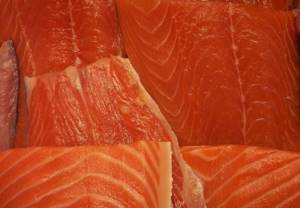
Rich in potassium, calcium, fluorine, phosphorus, iron, omega-3 and omega-6 acids, zinc, nickel, molybdenum, sodium, chromium, magnesium.
Contains vitamins A, B1, B2, C, E, PP. Per 100 grams of meat there are:
Chum salmon caviar is very popular in the fish market. It is rich in potassium, calcium and phosphorus. Its protein contains healthy amino acids in abundance.
This representative of salmon has less calories and is more healthy. An ideal product for dietary nutrition.
